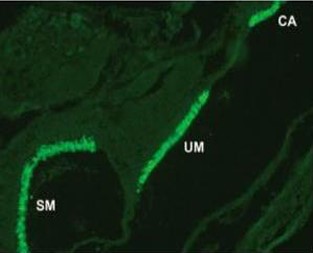Anti-Otoferlin [13A9]
Anti-Otoferlin [13A9]
Product No.: 90023
- -
- -
Clone 13A9 Target Otoferlin Formats AvailableView All Product Type Monoclonal Alternate Names Fer-1-like protein 2 Isotype IgG1 Applications IF , IHC , WB |
Data
- -
- -
Antibody DetailsProduct DetailsReactivity Species Human Host Species Mouse Immunogen GST fusion protein corresponding to aa 1-395 of human otoferlin (accession no. Q9HC10). Formulation Lyophilized, 0.1M Tris, 0.1M glycine, 2% sucrose, 1mg/ml. State of Matter Lyophilized Product Preparation Purified by Protein A affinity chromatography Storage and Handling This product is stable for at least one (1) year at -20°C to -70°C. Reconstituted product should be stored in appropriate aliquots to avoid repeated freeze-thaw cycles. Country of Origin USA Shipping Next Day 2-8°C Applications and Recommended Usage? Quality Tested by Leinco Immunoblotting: use at 1-5ug/mL. A band of ~220kDa is detected.
Immunofluorescence: use at 2-10ug/mL. These are recommended concentrations. Enduser should determine optimal concentrations for their applications. Each investigator should determine their own optimal working dilution for specific applications. See directions on lot specific datasheets, as information may periodically change. DescriptionSpecificity Mouse Monoclonal Antibody specific to Otoferlin Background Otoferlin protein is the product of the OTOF gene. Otoferlin is present in the brain and the cochlea of the inner ear where sound is processed. Hearing relies on Ca2+ influx-driven exocytosis of synaptic vesicles at the ribbon-type active zones of hair cells. The presence of several C2 domains in otoferlin, some of which bind Ca2+, suggest that otoferlin is a Ca2+ sensor for fusion in inner hair cell (IHC) synapses. Antigen DetailsFunction Key calcium ion sensor involved in the Ca(2+)-triggered synaptic vesicle-plasma membrane fusion and in the control of neurotransmitter release at these output synapses. Interacts in a calcium-dependent manner to the presynaptic SNARE proteins at ribbon synapses of cochlear inner hair cells (IHCs) to trigger exocytosis of neurotransmitter. Also essential to synaptic exocytosis in immature outer hair cells (OHCs). May also play a role within the recycling of endosomes (By similarity). {UniProtKB:Q9ESF1}. NCBI Gene Bank ID UniProt.org Research Area Neuroscience References & CitationsTechnical Protocols |



